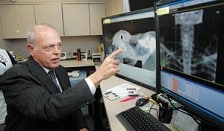Stoddard Cancer Center makes high-tech leap

Sometimes, a health-care specialist is just in the right place at the right time.
That’s how Dr. Robert Goebel, radiation oncology director for John Stoddard Cancer Center, feels about the newest cancer-fighting radiation technology that’s about to be delivered to his department.
The cancer center, located on the Iowa Methodist Medical Center campus, had just begun shopping for a new linear accelerator when one of the most technologically advanced radiosurgery treatment systems available, the TrueBeam STX, was approved by the federal government for use by hospitals last April.
“We were very lucky and very blessed to be in the right place at the right time,” said Goebel, an Ivy League-trained radiation oncologist who joined Stoddard two years ago after leading a hospital oncology department in Long Beach, Calif., for 23 years.
When Stoddard begins using the system in February, it will be among the first cancer centers in the nation to operate the advanced linear accelerator, which will enable it to handle a broader array of difficult-to-treat cancers than ever before. On average, about 50 percent of patients treated at Stoddard will receive some form of radiation treatment.
The new system, which will replace the oldest of three linear accelerators used to provide radiation treatments at Stoddard, offers “great precision, faster treatments, real-time imaging and versatility in the techniques that we can use to treat tumors,” Goebel said. “It really lets us do a lot more than anybody’s been able to do previously. So we’re very excited about it.”
With an installed cost of nearly $6 million, the TrueBeam STX system is also the largest single investment in the cancer center’s history, said Carma Herring, Stoddard’s executive director.
“But what we look at is not so much the expense but what it can bring back to the patient,” she said. “That’s our primary focus – what can we provide patients?”
Herring said that such major expenditures are typically divided into three pieces, with one-third of the funding from the regular budget, one-third from the Iowa Health Foundation and one-third from donations.
TrueBeam represents the latest in a succession of improvements to linear accelerator technology, which has been around since the late 1960s, said Goebel, who completed his medical residency with the Harvard Joint Center for Radiation Therapy. His training also includes an internship with North Shore University Hospital and Memorial Sloan-Kettering Cancer Center, a fellowship with Harvard Medical School and research training with the National Cancer Institute.
“The machine that we’re getting now allows us to be much more precise and treat a wider variety of irregular-shaped tumors surrounding critical structures,” he said. When I was at Harvard in the late ’70s, we were thinking of doing this, but we couldn’t. I tell some of the younger (doctors), ‘You don’t know how lucky you are to be here with this technology.’”
For some tumors, the new system will enable Goebel and his colleagues to deliver treatments dramatically faster than with the other two linear accelerators.
“You can have the best treatment plan in the world, but if the patient is lying there for an hour and a half in pain and discomfort, you can’t physically deliver it,” he said. “For some of these high-dose tumors that we’re treating now, it normally takes an hour and a half to two hours to do a treatment. We’ll be able to do those treatments now in 15 to 20 minutes.”
The TrueBeam system will also provide doctors with real-time imaging of tumors as they’re being treated, “which gives us an even higher degree of confidence that we’re treating the right area,” Goebel said. By comparison, until about 12 years ago, it was difficult to even determine where the tumor was located, he said, and it wasn’t until about five years ago that image-guided radiation therapy, using a static image taken prior to the procedure, came into practice.
The machine will be used by a broad array of specialists in treating various types of cancers, among them cancers of the brain, spinal cord, liver and pancreas, Geobel said. “This will be very multidisciplinary,” he said. “We expect to have a lot of (doctors) wandering around the department.”
Overall, cancer centers are working hard to keep up with an increasing number of patients each year, Goebel said.
“It’s difficult to say why that is,” he said. “This year or last year, the age-specific death rate for cancer has surpassed that for heart disease. There are many of us Baby Boomers that are getting to that age. Plus there are probably more toxins around, so we’re seeing more cancers.
“The machines keep getting better, the technology keeps getting better, and we’re doing our best to keep abreast of the growing need for our services.”










